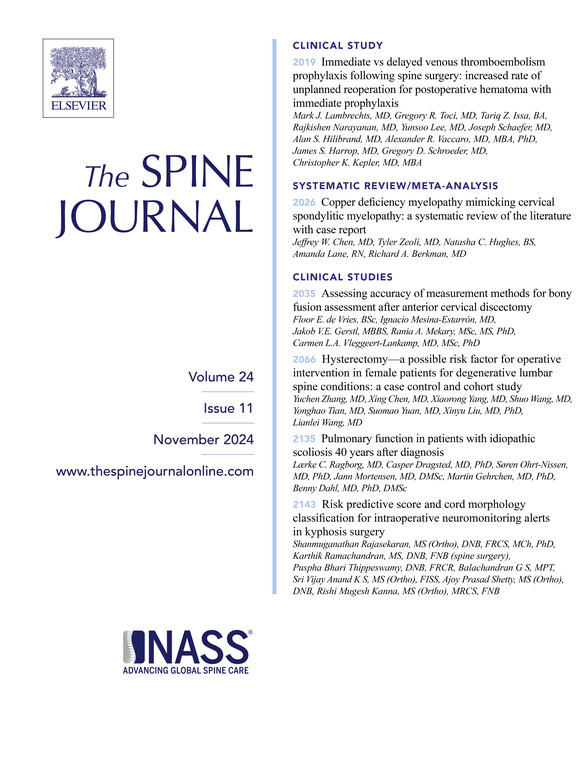身体发育与椎间盘:健康青少年的纵向磁共振成像研究。
IF 4.9
1区 医学
Q1 CLINICAL NEUROLOGY
引用次数: 0
摘要
背景情况:儿童和青少年腰背痛(LBP)是一个日益受到全球关注的问题。椎间盘退化(DD)被认为是导致腰背痛临床症状的一个重要因素。当青少年步入成年期时,腰背痛和椎间盘退化症都会变得更加普遍。目的:本研究旨在评估青春期生长高峰期身体发育与 18 岁时腰椎间盘形态之间的关系:研究设计:这是一项前瞻性纵向队列研究:研究样本:随机抽取了一批健康儿童,分别在 8 岁、11 岁和 18 岁时进行检查。本次分析纳入了 11 岁和 18 岁时拥有完整数据集(半结构式访谈、人体测量和腰椎核磁共振成像)的参与者(n=59):结果测量:通过磁共振成像评估腰椎间盘的形态特征。人体测量包括身高、坐高和体重,以计算体表面积(BSA)和体重指数(BMI):采用 Pfirrmann 分类法在 T2 加权中矢状磁共振成像上对腰椎间盘的形态进行评估。18 岁时,Pfirrmann 分级为 3 或更高的椎间盘被视为退化。评估了11至18岁之间的相对增长(根据性别和基线值进行调整)与18岁时椎间盘退变之间的关系。为了分析 BSA 相对增长与 DD 之间的关系,参与者被分为三个大小相等的类别(三等分)。对于所有其他人体测量指标,则根据 11 至 18 岁期间各项指标的相对增幅进行分析:在 BSA 相对增幅最高的三等分组(≥43%)中,76% 的参与者在 18 岁时至少有一个椎间盘达到或超过 Pfirrmann 3 级,而在最低和中等三等分组中,分别只有 10% 和 21% 的参与者有 DD。经性别和基线调整后,BSA每增加10%,18岁时出现DD的几率比(OR)为1.08(1.02至1.15)。身高和坐高每增加 10%,18 岁时 DD 的性别和基线调整 OR(95% CI)分别为 10.5(1.60 至 68.7)和 7.92(1.19 至 52.72)。体重每增加 10%,18 岁时侏儒症的调整 OR 为 1.51(1.12 至 2.04),BMI 为 1.05(1.01 至 1.09):结论:11 岁至 18 岁期间的相对增长与成年后 DD 的发生有显著相关性。在调查的各项指标中,身高和坐高是不可改变的。在青春期生长高峰期保持理想体重可能有利于腰椎间盘的健康。本文章由计算机程序翻译,如有差异,请以英文原文为准。
Bodily growth and the intervertebral disc: a longitudinal MRI study in healthy adolescents
BACKGROUND CONTEXT
Low back pain (LBP) among children and adolescents is a growing global concern. Disc degeneration (DD) is considered a significant factor in the clinical symptom of LBP. Both LBP and DD become more prevalent as adolescents transition into emerging adulthood. However, the relationship between growth during the pubertal growth spurt and the morphology of lumbar discs has yet to be elucidated.
PURPOSE
This study aimed to assess the relationship between bodily growth during the pubertal growth spurt and the morphology of lumbar discs at age 18.
STUDY DESIGN
This study was a prospective longitudinal cohort study.
PATIENT SAMPLE
A randomly selected cohort of healthy children was examined at ages 8, 11, and 18. Participants with complete data sets (semi-structured interview, anthropometric measurements and lumbar spine MRI) at age 11 and 18 were included in this analysis (n=59).
OUTCOME MEASURES
The morphological characteristics of lumbar discs were evaluated on MRI. Anthropometric measures including height, sitting height and weight were obtained to calculate the Body Surface Area (BSA) and the Body Mass Index (BMI).
METHODS
The morphology of the lumbar discs was evaluated on T2-weighted midsagittal MRI using the Pfirrmann classification. A disc with a Pfirrmann grade of 3 or higher was considered degenerated at age 18. The relationship between relative growth between ages 11 and 18 (adjusted to sex and baseline values) and DD at age 18 was assessed. To analyze the relationship between the relative increase in BSA and DD, the participants were categorized into three equal-sized categories (tertiles). For all other anthropometric measures, the analysis was based on the relative increase in each measure between ages 11 and 18.
RESULTS
In the highest tertile of relative increase in BSA (≥43%), 76% of participants had at least 1 disc with a Pfirrmann grade 3 or higher at age 18 while only 10% and 21% of participants in the lowest and medium tertiles had DD, respectively. The sex- and baseline-adjusted odds ratio (OR) for DD at age 18 for every additional 10% increase in BSA was 1.08 (1.02–1.15). The sex- and baseline-adjusted OR (95% CI) for DD at age 18 was 10.5 (1.60–68.7) and 7.92 (1.19–52.72) with every additional 10% increase in height and sitting height, respectively. For every additional 10% increase in weight, the adjusted OR for DD at age 18 was 1.51 (1.12–2.04) and for BMI 1.05 (1.01–1.09).
CONCLUSIONS
More relative growth between ages 11 and 18 is significantly associated with the occurrence of DD in emerging adulthood. Among the measures investigated, height and sitting height are nonmodifiable. Maintaining an ideal body weight during the pubertal growth spurt may be beneficial for the health of the lumbar discs.
求助全文
通过发布文献求助,成功后即可免费获取论文全文。
去求助
来源期刊

Spine Journal
医学-临床神经学
CiteScore
8.20
自引率
6.70%
发文量
680
审稿时长
13.1 weeks
期刊介绍:
The Spine Journal, the official journal of the North American Spine Society, is an international and multidisciplinary journal that publishes original, peer-reviewed articles on research and treatment related to the spine and spine care, including basic science and clinical investigations. It is a condition of publication that manuscripts submitted to The Spine Journal have not been published, and will not be simultaneously submitted or published elsewhere. The Spine Journal also publishes major reviews of specific topics by acknowledged authorities, technical notes, teaching editorials, and other special features, Letters to the Editor-in-Chief are encouraged.
 求助内容:
求助内容: 应助结果提醒方式:
应助结果提醒方式:


